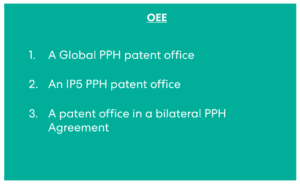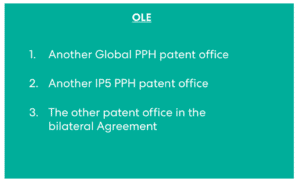What is PPH?
Patent Prosecution Highway (PPH) is a system of cooperation between patent offices. By agreement between the offices and on request of a patent applicant, the work product of one patent office that has already allowed the application or given a positive International Preliminary Report on Patentability (IPRP) (the Office of Earlier Examination “OEE”) is used in the examination of the patent application of the same family in another patent office (the Office of Later Examination “OLE”), provided that the applicant presents only the allowable claims in the OLE application.
PPH must be requested in the OLE before the OLE has begun its examination, and copies of relevant non-patent prior art and papers from the OEE examination (with translations if necessary) must be provided. The OLE will then usually examine the application soon after PPH is requested. Some patent offices have other requirements or exemptions, such as charging a fee for requesting PPH.
What are the Advantages of PPH?
In suitable cases, the PPH system can simplify and shorten the procedures for examination and grant of the different patent applications in the same family, and the statistical chance of obtaining allowance can be improved.
For example, data from the US Patent and Trademark Office (USPTO) show that in 2019 the allowance rate for applications on which PPH was requested was 84%, as compared to 74% overall[1], and the number of office actions was 1.5 on applications on which PPH was requested, as compared to 1.7 overall1.
The European Patent Office (EPO) will normally accelerate handling of an application on which PPH has been requested.[2]
What are the Disadvantages of PPH?
One notable disadvantage arises if the OEE and OLE differ substantially in the breadth of claiming that is allowed. For example, if the OEE takes a strict view of the extent to which a particular unexpected technical effect is demonstrated by the specific data in the case, then the degree of extrapolation and prediction represented by any claims that rely on that data for their patentability will be correspondingly narrow. If the OLE is a patent office that would be expected to take a more liberal view of the permitted degree of extrapolation, then using PPH is likely to result in a narrower patent in the OLE than might have been available through normal examination.
In jurisdictions, such as the USA, where statements made on the record by patent applicants during prosecution of their patent applications can be applied by a court to limit the enforceability of the patent against infringers, the need to certify that the claims in the OLE are no broader than the allowed claims in the OEE can potentially place statements on the record that may later be unhelpful to the patent owner.
Importantly, the OLE does not guarantee to grant the patent, as all of the normal requirements for grant of a patent by the OLE must still be complied with.
[1] https://www.ipwatchdog.com/2019/10/30/pph-program-uspto-favorable-stats-dont-alleviate-big-risks/id=115477/
[2] https://www.epo.org/law-practice/legal-texts/official-journal/2019/12/a106.html
Which Patent Offices are in the PPH System?
Generally speaking, the OEE and OLE can be selected in any particular case according to one of three options:


- Global PPH
The Global PPH patent offices are currently:
Europe: Austria (AT), Germany (DE), Denmark (DK), Estonia (EE), Spain (ES), Finland (FI), United Kingdom (GB), Hungary (HU), Iceland (IS), Norway (NO), Poland (PL), Portugal (PT), Sweden (SE), Nordic Patent Institute (XN), Visegrad Patent Institute (XV)
Other: Australia (AU), Canada (CA), Colombia (CO), Israel (IL), Japan (JP), Korea (KR), New Zealand (NZ), Peru (PE), Russia (RU), Singapore (SG), USA (US)
- IP5 PPH
The IP5 PPH patent offices are currently:
Europe: European Patent Office (EP)
Other: China (CN), Japan, Korea and USA
- Bilateral PPH Agreements
Bilateral PPH Agreements provide additional PPH options that are not covered by Global PPH and IP5 PPH. For example, bilateral PPH Agreements compensate to an extent for the fact that China and the European Patent Office are not members of Global PPH. There are many bilateral PPH Agreements and their terms vary. Some provide for the work product of the OEE in its work in the international phase of PCT patent applications to be available for use by the OLE (so-called “PCT-PPH Agreements”).
Notable examples of bilateral PPH Agreements outside the Global PPH framework and involving patent offices in Europe include:
China and: Germany (non-PCT work product only), Austria, Czech Republic (CZ), Denmark, Spain, Finland, United Kingdom, Hungary, Iceland, Norway, Poland, Portugal and Sweden
European Patent Office and: Australia, Canada, Israel, Russia and Singapore
Within the available options, the OLE is selected after one patent office (the OEE) has provided a suitable positive report. The PPH Request should normally be filed at the earliest opportunity, to observe the requirement that the Request is filed before the OLE has begun its examination. Depending on the patent offices in which applications in the family have been filed, and which have provided positive reports, more than one of the three PPH options can be used to provide maximum use of the PPH system.
What Types of PPH Request Are Possible?
Generally speaking, two types of PPH request are possible, although – as noted above in the case of the bilateral PPH Agreement between Germany and China – not all patent offices recognise both types:
- Use of the OEE’s work product from its activity as a national examining patent office;
- Use of the OEE’s work product from its activity in the international phase of a PCT patent application.
Examples and Q&A
Question 1: A positive IPRP has been produced in relation to at least some claims by the USPTO in the international phase of a PCT application. If the claims are correspondingly amended for Europe (if necessary), can PPH be requested on entry into the EP regional phase?
Answer: Yes. A request for PPH under the IP5 PPH option, naming the USPTO as the OEE, can be filed in connection with the EP regional phase at any time up to the start of the substantive examination in the EPO.
Question 2: A positive IPRP has been produced in relation to at least some claims by the Chinese National Intellectual Property Administration (CNIPA) in the international phase of a PCT application. If the claims are correspondingly amended for Germany and the UK (if necessary), can PPH be requested on entry into the German and UK national phases?
Answer: Yes, although the provisions differ between the UK and Germany. A request for PPH can be filed in the UK under the Bilateral China-UK PCT-PPH Agreement, naming CNIPA as the OEE. The request must be filed in connection with the UK national phase at any time up to the start of the substantive examination in the UKIPO. For Germany, the applicant must wait until CNIPA has issued a positive examination report in the corresponding Chinese national phase, or in another Chinese national patent application in the family, and then the applicant can request PPH under the Bilateral China-Germany PPH Agreement, naming CNIPA as the OEE. Alternatively, as soon as another positive report has been issued by any other national phase patent office in the Global PPH system or in a Bilateral PPH Agreement with Germany, PPH can be requested in Germany naming that patent office as OEE.
Question 3: Please direct me to some real cases where PPH was used in the examination and grant of European patents.
Answer: A first example is European Patent No. 3124482, which was examined and granted on a PPH request citing CNIPA as the OEE and based on PCT work product of that office, under the IP5 PPH option. The on-line file is available at https://register.epo.org/application?number=EP15768666.
A second example is European Patent No. 3153164, which was examined and granted on a PPH request citing CNIPA as the OEE and based on a positive examination of the Chinese patent application from which priority was claimed, under the IP5 PPH option. The on-line file is available at https://register.epo.org/application?number=EP15822401.
Sources of Further Information and Advice
This is for general information only and does not constitute legal advice. Should you require advice on this or any other topic then please contact Joanna Deas or your usual HLK advisor.
A PDF of this information can be accessed here.